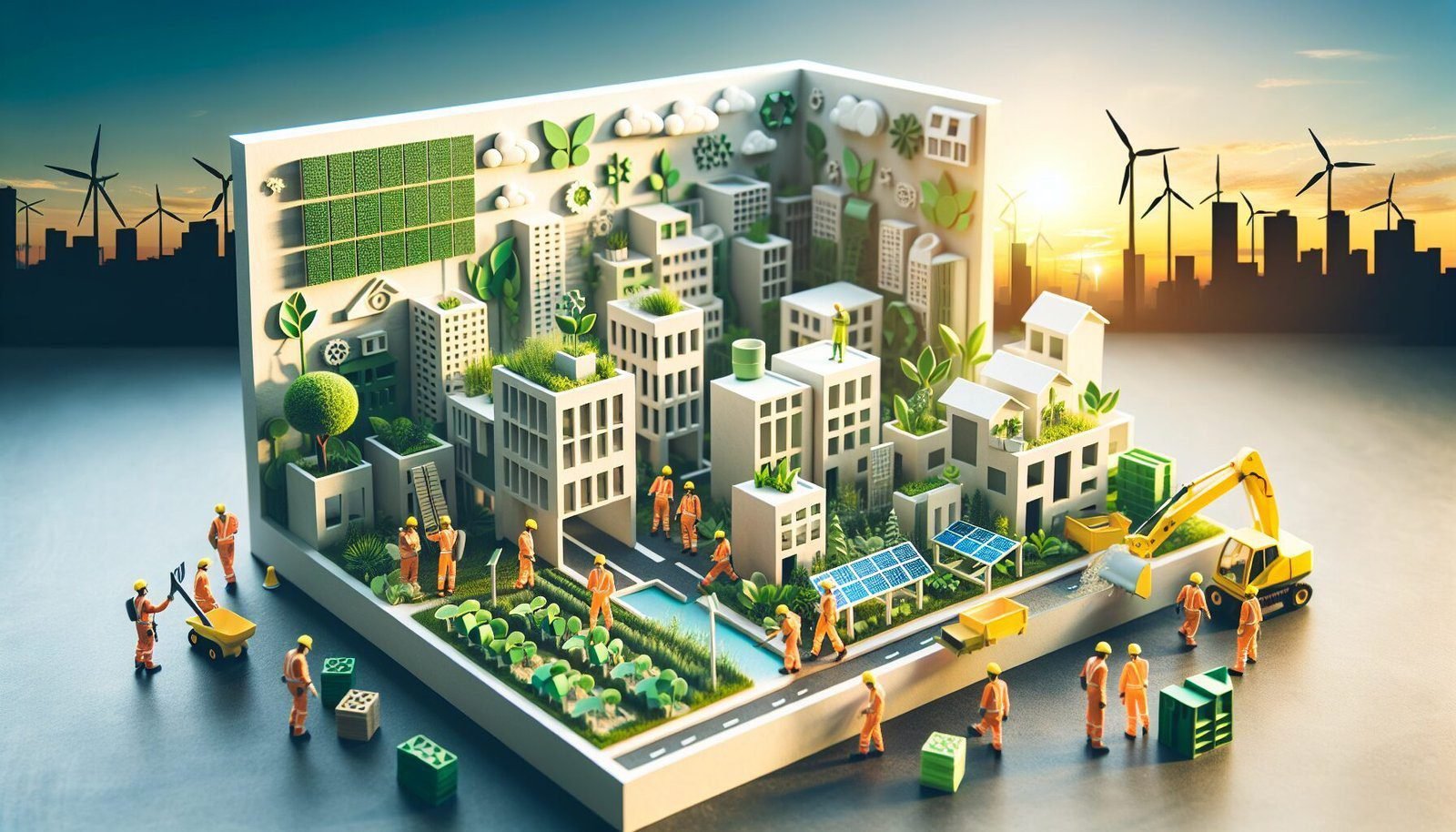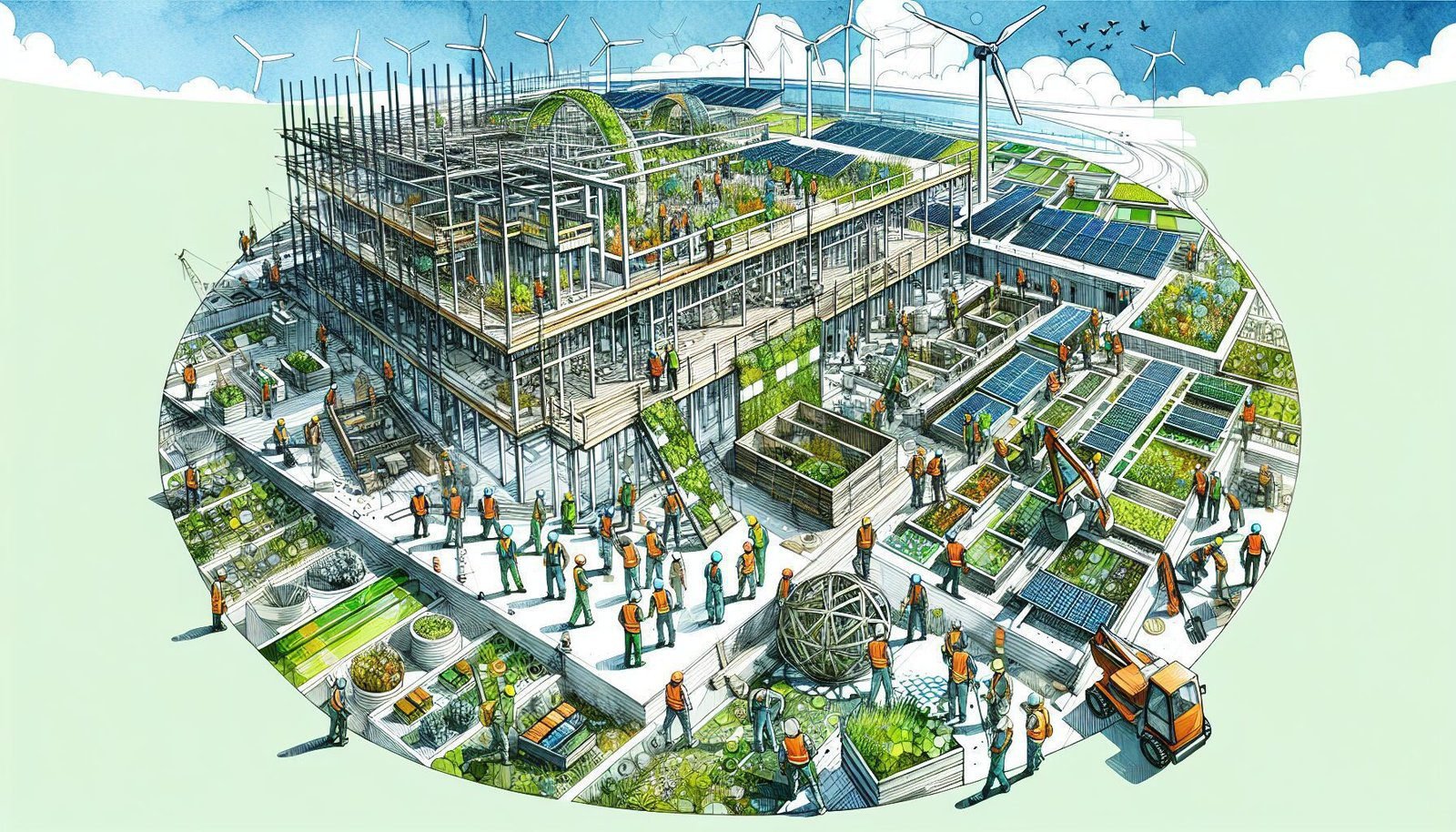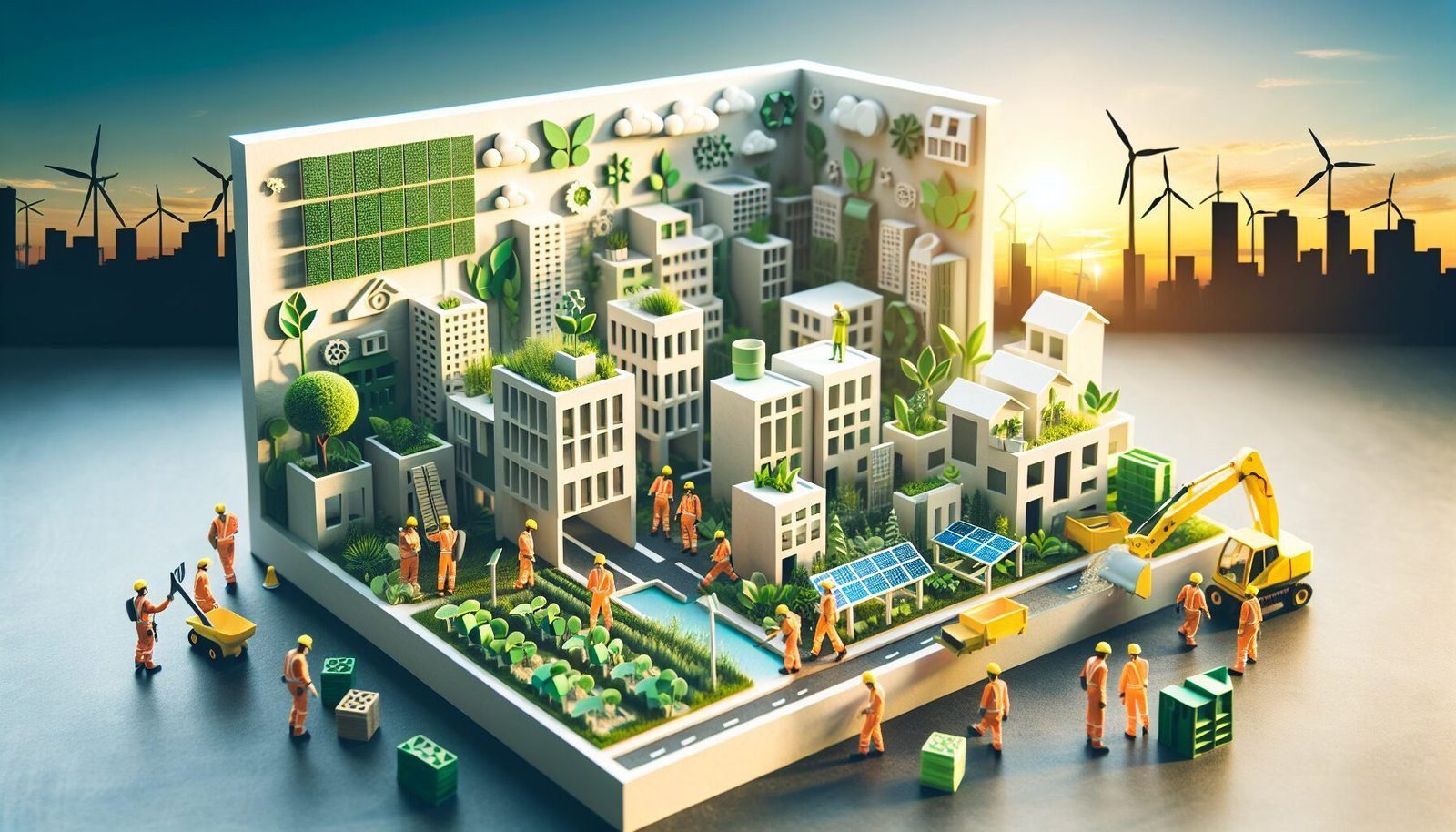December 25, 2023
Green Building: Essential Tools for Eco-Friendly Construction
The shift towards sustainability has never been more critical, and in the realm of architecture and construction, green building stands as a beacon of eco-conscious development. “Green Building: Essential Tools for Eco-Friendly Construction” is a comprehensive guide that explores the innovative tools and methods at the forefront of environmentally responsible construction. It sheds light on how industry professionals are harnessing cutting-edge technology and sustainable materials to reduce the carbon footprint of new structures while promoting energy efficiency. This insightful article serves as an invaluable resource for anyone looking to contribute to a greener future through the built environment.

Understanding Green Building
Definition of Green Building
Green building refers to the practice of creating structures and using processes that are environmentally responsible and resource-efficient throughout a building’s life cycle. This concept extends from siting to design, construction, operation, maintenance, renovation, and demolition. The goal of green building is not only to reduce the environmental impact of construction and building operation but also to create healthier and more sustainable living and working environments for occupants.
Significance of Eco-Friendly Construction
Eco-friendly construction has gained importance as the world grapples with climate change, resource depletion, and a growing awareness of the health impacts associated with traditional building methods. Constructing buildings that can minimize energy consumption, reduce greenhouse gas emissions, and utilize materials that are less harmful to the environment is now seen as a commitment to future generations. Moreover, it helps in the conservation of non-renewable resources and supports the well-being of the local and global ecosystems.
Principles of Sustainable Design
The principles of sustainable design are the cornerstone of green building. They include optimizing site potential, minimizing non-renewable energy consumption, using environmentally preferable products, protecting and conserving water, enhancing indoor environmental quality, and optimizing operational and maintenance practices. These principles guide architects, engineers, developers, and contractors in creating buildings that significantly reduce or eliminate the negative impact of construction on the environment and its occupants.
Green Building Certifications
LEED: Leadership in Energy and Environmental Design
LEED is one of the most widely recognized green building certification programs worldwide. It provides a framework for healthy, efficient, carbon, and cost-saving green buildings. LEED certification is a globally recognized symbol of sustainability achievement and leadership. It covers various aspects such as energy savings, water efficiency, CO2 emissions reduction, and improved indoor environmental quality.
BREEAM: Building Research Establishment Environmental Assessment Method
BREEAM is another pioneering method of assessing, rating, and certifying the sustainability of buildings. It sets the standard for best practice in sustainable building design, construction, and operation. BREEAM has been used to certify the environmental performance of buildings in various categories including energy, land use, and ecology.
WELL Building Standard
The WELL Building Standard focuses on the impacts of buildings on human health and well-being. WELL measures attributes of buildings that impact occupant health by looking at seven factors: air, water, nourishment, light, fitness, comfort, and mind. It has emerged as a tool to ensure spaces provide a healthy and productive environment for those who use them.
Comparative Analysis of Certification Systems
While all these certification systems have the same goal of promoting sustainability, they differ in their focus and methodologies. LEED has a significant emphasis on energy efficiency and carbon reduction. BREEAM is known for its comprehensive approach to assessing the overall sustainability of buildings. WELL prioritizes human health and well-being within the built environment. Green building teams often compare these certifications to choose the best fit for their project’s goals.
Design Tools for Green Building
Computer-Aided Design (CAD) Software with Sustainability Features
CAD software with sustainability features is an indispensable tool for architects and engineers. These tools help in designing efficient buildings by incorporating green elements from the early stages of design. They offer features like energy analysis, materials selection, and daylight modeling to ensure that the design adheres to sustainable building standards.
Building Information Modeling (BIM) for Green Construction
BIM is a process supported by various tools and technologies involving the generation and management of digital representations of physical and functional characteristics of places. When used for green construction, BIM can help in creating more accurate energy models, choose materials more efficiently, and manage construction waste more effectively.
Energy Modeling and Simulation Tools
Energy modeling and simulation tools are used extensively for designing high-performance buildings by predicting how much energy they will consume once operational. This helps in making informed decisions about HVAC systems, insulation, glazing, and other factors that affect a building’s energy use.
Daylighting and Shading Analysis Software
Daylighting and shading analysis software help in maximizing natural light inside the building while minimizing glare and heat gain. This software provides critical information that can influence the placement and sizing of windows, as well as the selection of shading devices to enhance occupant comfort and reduce reliance on artificial lighting.
Sustainable Materials Sourcing
Life Cycle Assessment Tools for Materials
Life Cycle Assessment (LCA) tools are used to evaluate the potential environmental impacts of building materials over their entire life cycle, from extraction and manufacturing to use and final disposal. Using LCA tools helps in selecting materials with a lower environmental footprint, which is a key component of sustainable building.
Certifications for Sustainable Materials
There are many certifications available that guarantee the sustainability of building materials, such as the Forest Stewardship Council (FSC) certification for wood products and ENERGY STAR for various building components. These certifications assist builders and designers to choose materials that meet specific sustainability criteria.
Recycled and Reclaimed Material Resources
Recycled and reclaimed materials reduce the need for virgin resources and can lower the environmental impact of a building project. There is a growing range of products from structural elements to finishes that incorporate recycled content, contributing to greener construction practices.
Evaluating Local and Renewable Material Options
Using local and renewable material options can greatly reduce the environmental impact associated with transportation and support local economies. Materials like bamboo, cork, and straw bale are considered renewable and can be sourced sustainably.

Energy Efficiency and Renewable Energy
Solar Photovoltaic (PV) System Design Tools
Design tools for solar PV systems are crucial for integrating renewable energy into buildings. These tools help in assessing the potential solar energy generation, considering factors like roof orientation, tilt, and shading, thus optimizing the PV system design for maximum efficiency.
Wind Energy Assessment Software
For projects considering wind energy as a renewable source, assessment software can analyze local wind data and predict the performance of wind turbines. This information is vital for determining the feasibility and expected energy output from wind energy systems.
Energy Management and Monitoring Systems
Energy management and monitoring systems are key to ensuring that buildings operate as efficiently as possible. These systems track energy consumption in real-time and can provide insights for improving performance and reducing waste.
Insulation and Building Envelope Optimization
The building envelope plays a critical role in maintaining energy efficiency. Insulation and envelope optimization can significantly reduce heat loss in winter and heat gain in summer, leading to reduced energy consumption for heating and cooling.
Water Conservation Strategies
Water Footprint Assessment Tools
Water footprint assessment tools help determine the amount of water used throughout a building’s life cycle. These tools aid in identifying areas where water usage can be reduced without compromising performance or comfort.
Rainwater Harvesting Calculators
Rainwater harvesting calculators assist in designing systems that capture and store rainwater for on-site use, such as irrigation or toilet flushing. This reduces the demand on municipal water supplies and can play a significant role in water conservation efforts.
Greywater and Blackwater Treatment Solutions
Greywater and blackwater treatment solutions allow for the reuse of waste water from sinks, showers, and toilets. Treated water can be used for non-potable purposes, greatly reducing freshwater consumption and the load on sewage systems.
Water-Efficient Landscaping Design Software
Water-efficient landscaping design software is used to create outdoor spaces that require minimal irrigation. These tools plan for native and drought-resistant plants and incorporate features like efficient irrigation systems and rain gardens.

Waste Reduction and Management
Construction Waste Minimization Techniques
Employing construction waste minimization techniques like prefabrication, modular construction, and careful material ordering can drastically reduce the amount of waste generated on a construction site, promoting sustainability and reducing costs.
Material Recovery and Recycling Programs
Material recovery and recycling programs ensure that waste from construction sites is diverted from landfills and recycled whenever possible. Creating partnerships with local recycling facilities can streamline this process.
Deconstruction and Waste Audit Tools
Deconstruction and waste audit tools offer a systematic approach to dismantle buildings in a way that allows materials to be recovered and reused. Conducting waste audits can also reveal opportunities to reduce waste generation.
Composting Solutions for Organic Waste
Composting solutions enable the on-site management of organic waste, turning it into valuable compost that can be used to improve soil quality. This practice can remarkably decrease the total waste sent to landfills from a building project.
Indoor Environmental Quality (IEQ)
IEQ Monitoring and Assessment Tools
IEQ monitoring and assessment tools measure various indoor environmental parameters such as air quality, lighting levels, and acoustics. Maintaining good IEQ is crucial for occupant health and productivity, and these tools form an essential part of ensuring a building’s interior meets high standards.
Ventilation and Air Quality Simulations
Ventilation and air quality simulations model the flow of air within buildings, helping to optimize the design of ventilation systems for both energy efficiency and good indoor air quality.
Low-Emitting Materials Selection
Selecting low-emitting materials for interiors, such as paints, adhesives, and flooring, can reduce the levels of volatile organic compounds (VOCs) inside buildings, improving the well-being of occupants.
Thermal Comfort Analysis Software
Thermal comfort analysis software enables designers to model and predict how different design choices can affect the thermal comfort of building occupants. This influences decisions on HVAC system design, insulation, and building materials.

Smart Building Technologies
Internet of Things (IoT) for Energy Efficiency
The Internet of Things (IoT) consists of connected devices that can monitor and control various building systems to enhance energy efficiency. Smart sensors, meters, and controls work together to optimize building operation and reduce energy usage.
Building Automation and Control Systems
Building automation and control systems provide centralized control of a building’s heating, ventilation, air conditioning, lighting, and other systems. These systems can significantly improve building performance by enabling real-time adjustments based on occupancy and other variables.
Smart Lighting and HVAC Controls
Smart lighting and HVAC controls use sensors and automation to adjust lighting levels and temperature based on occupancy and ambient conditions. This not only enhances comfort but also reduces energy consumption by ensuring that these systems are used only when needed.
Predictive Maintenance Software
Predictive maintenance software analyzes data from various building systems to anticipate when maintenance should be performed. This proactive approach can prevent system failures, reduce downtime, and extend the lifespan of equipment.
Project Management for Green Building
Green Construction Project Management Software
Project management software tailored for green construction can improve the efficiency and effectiveness of the building process. This software helps in managing schedules, budgets, materials, and compliance with environmental regulations, all within the paradigm of sustainability.
Tracking and Reporting Sustainability Metrics
Tracking and reporting sustainability metrics ensure that a green building project stays on target with its environmental goals. Real-time dashboards and reporting tools can inform stakeholders about progress towards energy efficiency, water conservation, and waste reduction targets.
Collaboration Platforms for Sustainable Building Teams
Collaboration platforms enable all members of a sustainable building team to communicate and share information effectively. These tools support the complex workflow of green building projects, ensuring that everyone is on the same page regarding sustainable practices.
Cost-Benefit Analysis for Green Building Features
Cost-benefit analysis tools help stakeholders understand the long-term economic impacts of green building features. They calculate the return on investment for sustainable strategies, considering factors like energy savings, water conservation, and increased property values, thus making a compelling case for green building investments.

























